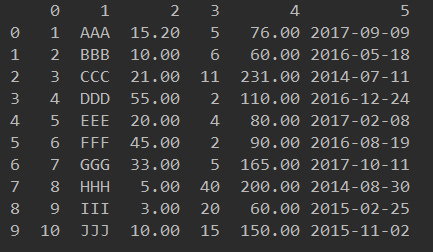Mysql表数据:

demo.sql内容
create table demo( id int ,product varchar(50) ,price decimal(18,2) ,quantity int ,amount decimal(18,2) ,orderdate datetime ); insert into demo select 1,'AAA',15.2,5,76,'2017-09-09' union all select 2,'BBB',10,6,60,'2016-05-18' union all select 3,'CCC',21,11,231,'2014-07-11' union all select 4,'DDD',55,2,110,'2016-12-24' union all select 5,'EEE',20,4,80,'2017-02-08' union all select 6,'FFF',45,2,90,'2016-08-19' union all select 7,'GGG',33,5,165,'2017-10-11' union all select 8,'HHH',5,40,200,'2014-08-30' union all select 9,'III',3,20,60,'2015-02-25' union all select 10,'JJJ',10,15,150,'2015-11-02';
实现效果如下:

Python代码:
1 import pymysql 2 import pandas as pd 3 import plotly.plotly 4 import plotly.graph_objs as pg 5 6 7 def bar_chart(host, port, user, passwd, dbname, charset,output_path): 8 try: 9 conn = pymysql.Connection( 10 host=host, 11 port=port, 12 user=user, 13 passwd=passwd, 14 db=dbname, 15 charset=charset 16 ) 17 cur = conn.cursor() 18 cur.execute("select * from demo;") 19 # cursor对象使用MySQL查询字符串执行查询,返回一个包含多个元组的元组——每行对应一个元组 20 rows = cur.fetchall() 21 # print(rows) 22 23 # 使用Pandas的DataFrame来处理每一行要比使用一个包含元组的元组方便 24 # 下面的Python代码片段将所有行转化为DataFrame实例 25 df = pd.DataFrame([[ij for ij in i] for i in rows]) 26 print(df) 27 df.rename(columns={0: 'id', 1: 'product', 2: 'price', 3: 'quantity', 4: 'amount', 5: 'orderdate'}, inplace=True) 28 # df = df.sort(['LifeExpectancy'], ascending=[1]) 29 30 date_price = pg.Bar(x=df["product"], y=df["price"], name='价格') 31 date_quantity = pg.Bar(x=df["product"], y=df["quantity"], name='数量') 32 date_amount = pg.Bar(x=df["product"], y=df["amount"], name='总价') 33 data = [date_price, date_quantity, date_amount] 34 35 layout = pg.Layout(barmode='group', title="各产品销售情况") 36 fig = pg.Figure(data=data, layout=layout) 37 plotly.offline.plot(fig, filename=output_path) 38 39 finally: 40 if conn: 41 conn.close() 42 43 44 if __name__ == '__main__': 45 output_path = "C:/Users/fuqia/Desktop/bar.html" 46 bar_chart("localhost", 3306, "root", "123456", "test", "utf8", output_path)
输出df内容如下: